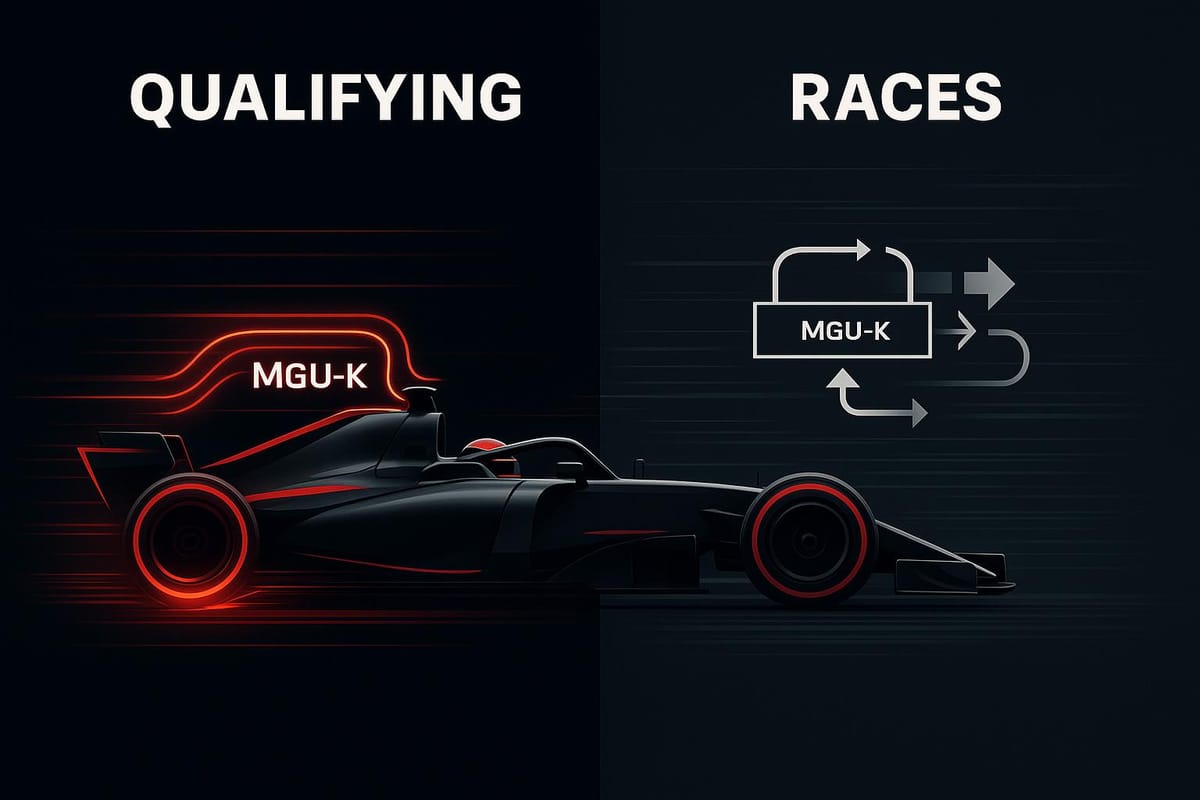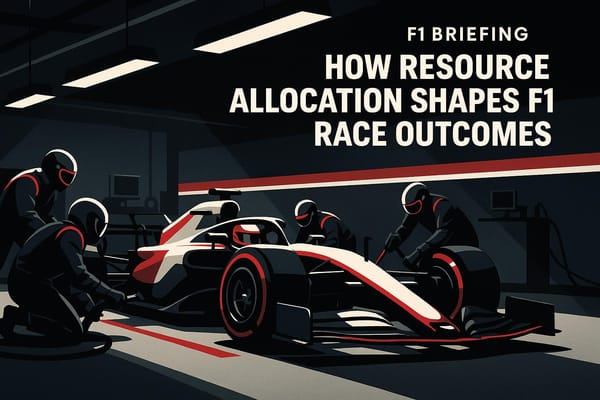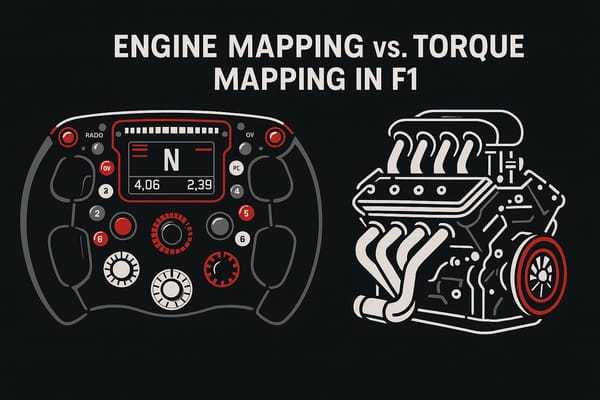MGU-K Performance in Qualifying vs. Races
Explore the contrasting strategies of MGU-K performance in qualifying and race conditions, highlighting energy management and efficiency.

The MGU-K (Motor Generator Unit - Kinetic) in Formula 1 plays a critical role in energy recovery and deployment. In qualifying, it’s all about maximum power for a single lap, while in races, the focus shifts to balancing energy recovery, fuel efficiency, and durability. Here’s a quick breakdown:
-
Qualifying:
- Full 120 kW (161 hp) power deployed for peak speed.
- Aggressive energy use with "Hotlap" mode.
- Prioritizes single-lap performance over efficiency.
-
Race:
- Energy recovery during braking (up to 2 MJ/lap).
- Controlled deployment (max 4 MJ/lap) for overtaking and strategy.
- Balances power, fuel limits (110 kg), and system durability.
Quick Comparison
| Aspect | Qualifying | Race |
|---|---|---|
| Power Output | Max 120 kW for single lap | Controlled bursts (4 MJ limit) |
| Energy Recovery | Minimal | Continuous (up to 2 MJ per lap) |
| Focus | Speed and grid position | Efficiency, strategy, and overtaking |
| Mode | "Hotlap" mode | Multiple modes (attack, charge) |
The MGU-K’s adaptability is key to success, with teams tailoring strategies to track layouts and conditions. Upcoming 2026 regulations will significantly increase MGU-K power, reshaping energy strategies for both qualifying and races.
Race Vs. Quali Fast Laps: Where the Difference Lies
MGU-K Performance in Qualifying
The MGU-K plays a pivotal role during qualifying sessions, where the focus shifts to extracting the maximum possible speed over a single lap. Unlike race conditions, energy conservation takes a backseat, allowing teams to push the hybrid system to its absolute limits.
Energy Deployment for Single Laps
In qualifying, the MGU-K is tuned to deliver peak energy output for just one lap. Drivers engage a special "Hotlap" mode, which unleashes 120 kW of power using pre-programmed energy maps. These maps are tailored to optimize performance in critical areas of the track, such as corner exits and long straights.
"During qualifying, ERS is mostly used to its full power for a fast lap." - Aashna Singh, dive-bomb.com
Track Layout Effects
The layout of each circuit heavily influences how MGU-K energy is deployed in qualifying. On high-speed tracks like Monza, the MGU-K can operate near its maximum output during extended full-throttle sections, taking full advantage of the long straights and minimal braking zones. In contrast, technical circuits with frequent braking zones enable more efficient energy recovery through kinetic braking, though the shorter deployment windows require teams to be more strategic with energy use.
Teams fine-tune their energy management strategies based on the circuit's demands, balancing sustained power delivery with rapid energy recovery. These adjustments also guide how drivers utilize the system, ensuring that deployment techniques are tailored to the track's characteristics.
Driver Usage Differences
Drivers' individual styles significantly influence how effectively the MGU-K is used during qualifying. Some prefer to manually manage the ERS system, strategically conserving energy in less critical sections to maximize power where it counts most. When activating overtake mode, which provides an additional 161 horsepower boost, drivers often adapt their braking points to handle the extra acceleration.
MGU-K Performance in Race Conditions
Navigating race conditions with the MGU-K involves striking a delicate balance between performance, efficiency, and durability.
Energy Recovery and Fuel Efficiency
With a strict 110 kg fuel limit during races, the MGU-K plays a pivotal role in conserving fuel while maintaining competitive lap times. It recovers kinetic energy during braking, converting what would otherwise be wasted heat into electrical energy stored in the Energy Store.
This energy recovery isn't a one-off process - it runs throughout the race. The system operates on a 2:1 recovery-to-deployment ratio, requiring precise energy management to ensure optimal performance.
Fuel efficiency strategies like "lift and coast" further integrate with the MGU-K's functionality. In this technique, drivers ease off the throttle before braking zones to save fuel. Even during these moments, the MGU-K continues to recover energy through regenerative braking, helping to maintain the car's electrical reserves without compromising fuel consumption goals.
"Formula 1 fuel efficiency has become a critical focus in the world of motorsport, as teams strive to balance peak performance with stringent fuel regulations." - Emanuele Venturoli, RTR Sports
These strategies underline the importance of balancing power output with the durability of the system.
Performance vs. Durability Balance
Race conditions require teams to carefully weigh the trade-off between power and durability. The MGU-K can deliver an extra 160 horsepower, but this boost is only available for short bursts due to energy limitations.
Unlike qualifying, where maximum deployment takes priority, races demand a more measured approach. Aggressive energy deployment can accelerate tire wear, as higher cornering speeds and acceleration forces take their toll. Additionally, efficient cooling systems are critical during races to prevent the MGU-K from overheating under extended use. This directly impacts how aggressively teams can deploy electrical energy.
Race Scenario Adjustments
Adapting to dynamic race conditions, teams employ flexible MGU-K strategies. Drivers can switch between deployment modes - such as hotlap/overtake mode, charge mode, or balanced mode - using buttons on their steering wheel. These modes allow for tactical adjustments based on the immediate demands of the race.
During safety car periods, teams often reduce performance settings to minimize component stress and allow cooling. This strategic pause preserves the MGU-K for critical moments when racing resumes, especially during the intense battles that follow safety car restarts.
Overtaking maneuvers, in particular, require precise energy management. Teams carefully plan MGU-K deployment to provide the maximum electrical boost exactly when drivers need it most. Coordination between drivers and pit crews ensures that MGU-K usage aligns with evolving race conditions, making every watt of energy count.
These adaptive strategies emphasize the stark difference between the calculated energy management of race conditions and the all-out approach of qualifying laps.
Key Differences: Qualifying vs. Race MGU-K Performance
Qualifying and race sessions demand entirely different approaches to MGU-K energy strategies, each tailored to meet specific goals.
Deployment Patterns and Energy Usage
During qualifying, teams push the MGU-K to its limits, delivering a constant 120 kW of power throughout the full load phase. This aggressive strategy prioritizes maximum power output, with the energy store set to full depletion (SOC set to 1). In contrast, race sessions require a more measured approach. Teams aim to maintain about 80% SOC at the end of each lap, ensuring a steady energy supply for various race scenarios. As a result, the average battery power deployed in races is significantly lower than in qualifying.
Here’s a quick breakdown of the strategies:
| Qualifying Mode | Race Modes | Primary Purpose |
|---|---|---|
| Max Power | Attack mode | Overtaking maneuvers |
| Energy Depletion | Balanced mode | Maintaining energy reserves |
| Single-lap focus | Build/Charge mode | Energy recovery periods |
These contrasting strategies directly influence efficiency and lap time outcomes.
Efficiency Metrics and Lap Time Impact
The efficiency trade-offs between qualifying and race conditions reveal the priorities of energy management. During races, cars recover more energy per lap compared to qualifying. This is partly due to the increased vehicle weight from the fuel load, which generates more kinetic energy during braking.
In race conditions, teams focus on minimizing energy losses rather than achieving short-term power bursts. They work within the 2 MJ per lap energy recovery limit, balancing this constraint with consistent performance. In qualifying, energy is allocated entirely toward achieving the fastest possible lap time. In races, however, energy is distributed tactically for overtaking, defending, and maintaining pace.
The practical effects of these strategies are particularly noticeable on high-performance circuits.
Case Study: High-Performance Circuits
High-power circuits like Spielberg vividly illustrate the differences in MGU-K strategies between qualifying and race sessions. At Spielberg, drivers can tap into an additional 161 horsepower for roughly half the lap, making precise energy deployment critical.
In qualifying at Spielberg, teams maximize both energy harvesting and deployment to secure the fastest lap times. The circuit’s design - with its limited corners and long straights - creates a high fuel consumption environment, pushing teams to optimize every bit of electrical energy.
In races, Spielberg presents a different challenge. Teams must carefully balance energy harvesting and deployment to handle various scenarios, such as overtaking or defending positions. The hybrid system’s duty cycle is optimized to ensure energy availability throughout the race.
Similarly, at longer circuits like Spa-Francorchamps, energy harvesting opportunities are more abundant. Qualifying strategies take full advantage of these zones for peak performance on a single lap. Race strategies, however, also factor in tire wear, fuel efficiency, and overall positioning. These circuit-specific challenges highlight how track characteristics shape MGU-K performance differently across the weekend. Teams often prepare pre-set maps tailored to specific track sections, but the core difference - maximum attack in qualifying versus strategic energy management in races - remains the hallmark of Grand Prix energy strategies.
Future Changes for MGU-K Usage
Big changes are coming to MGU-K technology as the 2026 regulations bring a new approach to energy management during both qualifying and races. These updates will not only boost power output but also push teams to rethink their strategies for every session on the track.
Impact of 2026 Power Unit Regulations
The 2026 regulations represent the most significant shift in hybrid technology since 2014. One of the standout changes is the near tripling of MGU-K power, jumping from 120 kW to 350 kW (469 hp). This shift will completely alter how teams approach both qualifying and race strategies.
Another game-changer is the new 50/50 power split between the internal combustion engine and electrical power. Currently, the ratio is around 80:20, so this adjustment marks a dramatic departure from current norms. Vincent Pereme, the FIA's head of powertrain, explains the benefits of this increase:
"Thanks to the much larger amount of electrical power available in '26, drivers will be able to harvest a lot more energy in the braking phase and then use that energy for the next acceleration. Additionally, a much bigger battery and more electrical power will mean the cleverest teams and drivers will be able to gain an advantage in using this electrical energy in the right part of the circuit."
With the removal of the MGU-H system, all energy recovery will now rely on the MGU-K. This unit will handle roughly 8.5 megajoules of energy recovery per lap during braking - double its current capacity. This change will create new challenges, as teams must juggle maximizing energy deployment for single-lap performance in qualifying with the need for consistent energy recovery over longer race stints.
Additionally, the introduction of the "MGU-K Override" system will give trailing cars an extra 0.5 MJ of energy and 350 kW of power, effective up to speeds of 337 kph. This feature is designed with racing in mind, potentially leading to a strategic split: qualifying may focus on raw power, while races lean into tactical energy management for overtaking.
The integration of active aerodynamics, including X-mode and Z-mode, adds even more complexity. Teams will need to carefully balance aerodynamic efficiency with energy deployment, especially as the new rules aim to cut drag by 55% and downforce by 30%.
Trends in Energy Recovery and Deployment
With these regulatory changes, the landscape of energy management is set to evolve further. The nearly 300% increase in electrification signals a move toward smarter, more precise energy recovery and deployment systems.
Teams are already grappling with the engineering challenges these updates bring. McLaren's Andrea Stella has raised concerns about the draft regulations, particularly regarding car performance:
"The way cars are in the draft version of the regulations... the cars are not fast enough in the corners and too fast in the straights. These two aspects need to be rebalanced."
The shift from fuel flow control to energy flow control offers engineers more room for innovation in electrical systems. This could lead to advanced energy recovery and deployment algorithms, tailored specifically for the differing demands of qualifying and racing.
Weight is another factor shaping energy recovery. Heavier cars, especially with full fuel loads during races, could enhance braking energy recovery. However, meeting the 30 kg weight reduction target is proving to be a significant hurdle. Williams' James Vowles shared his doubts:
"I don't think anyone will hit that weight target... It's going to be incredibly difficult, and I think that needs reviewing. As someone who spends their life going through marginal gains, taking weight out of a car, it's not a fun thing to do."
If teams fail to meet the weight reduction goals, heavier cars might actually benefit energy recovery during braking, particularly in race conditions.
The FIA has also acknowledged potential challenges with energy harvesting on certain tracks. To address this, they’ve allowed for adjustments to the standard 9 MJ/lap recharge limit on specific circuits. This flexibility hints at a future where energy recovery strategies could be tailored to individual tracks, further complicating team preparations.
Looking ahead, the focus is shifting away from internal combustion engine performance and toward electrical power systems. Jan Monchaux, FIA single-seater technical director, emphasized this shift:
"We want to have the focus of the development on the energy storage and the MGU-K, which means the combustion engine is not supposed to become as big a performance differentiator as it potentially is now."
This focus on electrical systems will likely sharpen the differences between qualifying and race strategies. Teams with superior energy management systems will have the edge, deploying their advantages in ways that suit each session's unique demands.
Conclusion
The contrasting use of the MGU-K in qualifying versus race conditions highlights the intricate balancing act teams navigate every race weekend. These differences go beyond just power output - they represent distinct energy management strategies that can sway championship standings.
During qualifying, teams push their hybrid systems to the limit. The MGU-K delivers its full 120 kW (around 161 horsepower) throughout nearly the entire full-throttle phase. The focus is on outright speed, with teams willing to drain their energy reserves to secure the best grid position. As Lewis Hamilton aptly puts it:
"Our quali mode is the most fun mode - it should be the 'party' mode. It is the most power and has the most juice, and it's when we hit the highest speeds."
In contrast, race strategies demand a more measured approach. Teams must juggle a 2 MJ energy recovery cap with a 4 MJ deployment limit, often relying on tools like the "overtake button" to balance efficiency with bursts of power. Track layouts also play a crucial role: high-speed circuits require conserving energy for overtaking opportunities, while technical tracks with heavy braking zones allow for more effective energy recovery. Teams adapt their strategies to suit each track's unique demands, proving just how critical precise energy management is to race-day success.
This meticulous approach to energy deployment often sets championship contenders apart. Teams must constantly tweak their strategies in response to ever-changing race conditions. Looking ahead, new regulations are expected to add another layer of complexity, challenging teams to refine how they use their hybrid systems in both qualifying and race scenarios.
Ultimately, this analysis underscores a key takeaway: MGU-K deployment strategies don’t just shape session tactics - they influence entire championship campaigns. Formula 1 remains the pinnacle of motorsport technology, where every split-second decision about energy use can mean the difference between winning and losing.
FAQs
How will the 2026 F1 regulations impact MGU-K performance and strategies in qualifying and races?
The 2026 Formula 1 regulations are set to shake things up, especially when it comes to how the MGU-K is used during qualifying and races. With the removal of the MGU-H, the MGU-K’s power output will jump to about 350 kW (470 bhp). This change means teams will have to rethink their energy management strategies to get the most out of their cars. For drivers, it’ll be all about carefully managing energy deployment, particularly during critical moments like overtaking or pushing for a fast lap.
One key adjustment is that energy deployment will now taper off at higher speeds - roughly between 180 mph and 220 mph. This shift will force teams to develop strategies that maintain efficiency without compromising lap times. On top of that, enhanced energy recovery under braking - up to 9 MJ per lap - opens the door for more aggressive braking and overtaking maneuvers. This added recovery capability will play a major role in shaping race and qualifying tactics. Ultimately, teams will need to strike the perfect balance between power output and energy conservation to remain competitive under these new rules.
How does the MGU-K improve fuel efficiency during a Formula 1 race?
The MGU-K (Motor Generator Unit - Kinetic) plays a key role in improving fuel efficiency in Formula 1 by capturing energy that would otherwise be wasted during braking. This recovered energy is transformed into electrical power, stored in the car's energy system, and later used to enhance performance, reducing reliance on the internal combustion engine.
By maximizing energy recovery and smartly reusing it, the MGU-K allows teams to manage fuel consumption more effectively during a race. This not only boosts the car's efficiency but also aligns with Formula 1's push toward reducing fuel waste and making better use of energy resources.
How does the track layout affect how the MGU-K is used in qualifying versus race conditions?
Track layouts significantly influence how the MGU-K (Motor Generator Unit-Kinetic) is used during both qualifying sessions and races. In qualifying, the primary goal is to squeeze out every bit of power for the fastest possible lap. Teams focus on aggressive energy deployment, using the MGU-K to deliver a powerful boost during acceleration. At the same time, energy recovery in braking zones is carefully planned, taking full advantage of the track's layout to maintain high speeds through corners.
During races, the approach shifts to managing energy over the long haul. Tracks with more braking zones offer better opportunities for energy recovery, which is key to staying competitive over multiple laps. Other factors, like fuel load and changing race conditions, also play a role in determining how the MGU-K is utilized. Teams constantly fine-tune their strategy, balancing energy recovery and deployment to ensure steady performance throughout the race.




